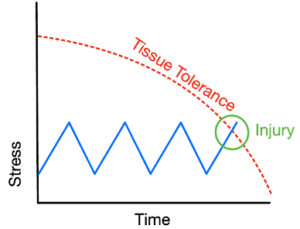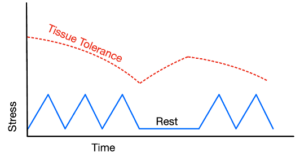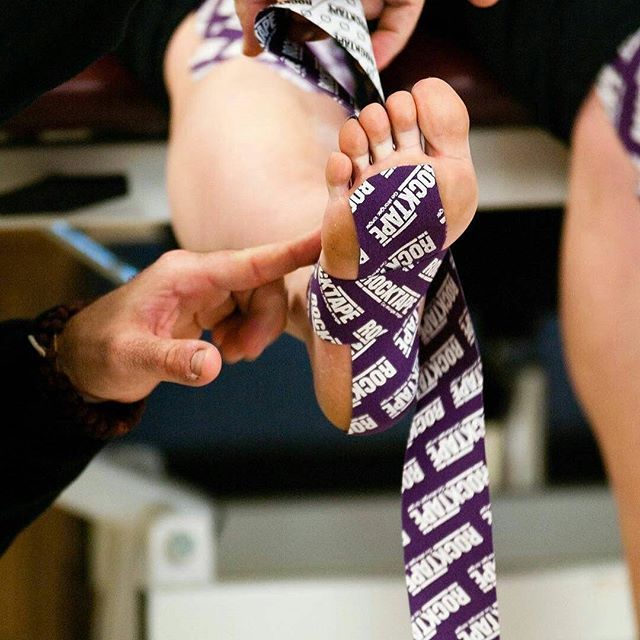Happy Feet: Plantar Fascia Management
Plantar fasciitis is a common foot condition that affects the plantar fascia, a thick band of tissue that runs along the bottom of the foot. It is characterized by both pain and stiffness in the heel and arch of the foot. This foot pain tends to be worsened by activities such as walking, running, or jumping. One of the most common complaints is a sharp pain at the bottom of the foot during the first few steps in the morning. In this blog post, we will discuss some ways to manage plantar fasciitis, but first, we need to talk about why people may develop this condition.
Tissue tolerance may be defined as a tissue’s capacity to withstand physical stress before injury occurs. This capacity can be improved through training and conditioning. However, if the body is not given enough time to recover between physical activity, it may exceed its tissue tolerance, which may result in injury.


Figure 1: Tissue tolerance curves demonstrating the difference in risk of injury by rest period.
This concept of tissue tolerance and lack of recovery leading to injury is especially relevant to plantar fasciitis. A study published in the Journal of Orthopaedic & Sports Physical Therapy found that decreased ankle range of motion, increased body mass index, and increased weekly running distance were all significant risk factors for developing plantar fasciitis. These risk factors may result in excessive stress on the plantar fascia, exceeding its tissue tolerance and leading to injury. Therefore, proper training and recovery strategies, such as activity modification, stretching, and self-massage, are crucial for preventing and managing plantar fasciitis.
Activity Modification
Activity modification is a helpful strategy for managing plantar fasciitis as the tissue on the bottom of the foot needs time to heal. To facilitate recovery, individuals can monitor their activity levels throughout the day/week. This means scheduling in rest days between activities that put a lot of stress on our feet such as challenging hikes, long-distance runs, and fitness classes that involve a lot of plyometrics. When a flare-up occurs, try avoiding these high-stress activities and treating your feet to some tender love and care as described further below.
Exercises and Stretches
Below are three exercises that can help prevent and manage plantar fasciitis.
Short foot: Sit in a chair with your feet flat on the ground and your toes pointing forward. Slowly lift the arch of your foot, curling your toes towards your heel without lifting your toes off the ground. Hold for 5-10 seconds and then release. Repeat 10-15 times.
Heel raises: Stand with your feet shoulder-width apart and slowly rise onto the balls of your feet, lifting your heels as high as possible. Hold for 3-5 seconds and then slowly lower your heels back down. Repeat 10-15 times.
Toe curls: Sit in a chair with a towel on the ground in front of you. Place the towel under your toes and use them to scrunch the towel towards you. Release and repeat 10-15 times.
Other treatments
Massaging the bottom of the foot in the morning before the first few steps of the day may help reduce the sharp pain that some people with plantar fasciitis may feel when they get out of bed. This is also a helpful strategy if you have been sitting at your desk for a prolonged period of time.


Figure 2: RockTape’s Nano Foot Roller and MB Vibe
Another technique for when individuals are experiencing pain in the plantar fascia is to roll their foot over a frozen water bottle, as it provides the soothing benefits of ice. Something I enjoy doing throughout the day is using RockTape’s Nano Foot Roller or the RockTape MB vibe to provide some assisted massaging into the plantar fascia.
Although custom orthotics are not a long-term solution to plantar fasciitis, they may be considered as another strategy for pain relief if the pain hasn’t subsided over several weeks using the techniques above. Custom orthotics can be an expensive option, therefore I tend to use a generic orthotic obtained from a local pharmacy to provide some short-term cushioning for the sole of my foot.
Conclusion
Plantar fasciitis can be a painful and frustrating condition, particularly when left untreated. I recommend working with a healthcare professional to develop an individualized plan to help manage plantar fasciitis. By making activity modifications, doing exercises and stretches, and considering other treatments, individuals may be able to find relief and get back to their daily activities.
Aaron Wallace BSc, MSc, RockTape Ambassador, Canadian Memorial Chiropractic College, Class of 2023, Clinical Representative, President of Soft Tissue Therapy Club and Rehab 2 Performance Club
Follow Aaron on IG
References
Morrissey D, Cotchett M, J’Bari AS, Prior T, Griffiths IB, Rathleff MS, Gulle H, Vicenzino B, Barton CJ. Management of plantar heel pain: a best practice guide informed by a systematic review, expert clinical reasoning, and patient values. British Journal of Sports Medicine. 2021 Oct 1;55(19):1106-18.
Riddle DL, Pulisic M, Pidcoe P, Johnson RE. Risk factors for Plantar fasciitis: a matched case-control study. Journal of Orthopaedic & Sports Physical Therapy. 2003;33(5):260-267. doi: 10.2519/jospt.2003.33.5.260. PMID: 12841486.
The information provided in this blog is for informational purposes only and should not be construed as medical advice. It is not intended to replace professional medical guidance, diagnosis, or treatment. Always seek the advice of a trained healthcare professional before making any changes to your medical treatment plan. The authors of this blog and the website on which it appears are not liable for any consequences arising from the use or reliance on the information provided.
